1.2: Right Triangle Trigonometry
- Page ID
- 59542
\( \newcommand{\vecs}[1]{\overset { \scriptstyle \rightharpoonup} {\mathbf{#1}} } \)
\( \newcommand{\vecd}[1]{\overset{-\!-\!\rightharpoonup}{\vphantom{a}\smash {#1}}} \)
\( \newcommand{\dsum}{\displaystyle\sum\limits} \)
\( \newcommand{\dint}{\displaystyle\int\limits} \)
\( \newcommand{\dlim}{\displaystyle\lim\limits} \)
\( \newcommand{\id}{\mathrm{id}}\) \( \newcommand{\Span}{\mathrm{span}}\)
( \newcommand{\kernel}{\mathrm{null}\,}\) \( \newcommand{\range}{\mathrm{range}\,}\)
\( \newcommand{\RealPart}{\mathrm{Re}}\) \( \newcommand{\ImaginaryPart}{\mathrm{Im}}\)
\( \newcommand{\Argument}{\mathrm{Arg}}\) \( \newcommand{\norm}[1]{\| #1 \|}\)
\( \newcommand{\inner}[2]{\langle #1, #2 \rangle}\)
\( \newcommand{\Span}{\mathrm{span}}\)
\( \newcommand{\id}{\mathrm{id}}\)
\( \newcommand{\Span}{\mathrm{span}}\)
\( \newcommand{\kernel}{\mathrm{null}\,}\)
\( \newcommand{\range}{\mathrm{range}\,}\)
\( \newcommand{\RealPart}{\mathrm{Re}}\)
\( \newcommand{\ImaginaryPart}{\mathrm{Im}}\)
\( \newcommand{\Argument}{\mathrm{Arg}}\)
\( \newcommand{\norm}[1]{\| #1 \|}\)
\( \newcommand{\inner}[2]{\langle #1, #2 \rangle}\)
\( \newcommand{\Span}{\mathrm{span}}\) \( \newcommand{\AA}{\unicode[.8,0]{x212B}}\)
\( \newcommand{\vectorA}[1]{\vec{#1}} % arrow\)
\( \newcommand{\vectorAt}[1]{\vec{\text{#1}}} % arrow\)
\( \newcommand{\vectorB}[1]{\overset { \scriptstyle \rightharpoonup} {\mathbf{#1}} } \)
\( \newcommand{\vectorC}[1]{\textbf{#1}} \)
\( \newcommand{\vectorD}[1]{\overrightarrow{#1}} \)
\( \newcommand{\vectorDt}[1]{\overrightarrow{\text{#1}}} \)
\( \newcommand{\vectE}[1]{\overset{-\!-\!\rightharpoonup}{\vphantom{a}\smash{\mathbf {#1}}}} \)
\( \newcommand{\vecs}[1]{\overset { \scriptstyle \rightharpoonup} {\mathbf{#1}} } \)
\( \newcommand{\vecd}[1]{\overset{-\!-\!\rightharpoonup}{\vphantom{a}\smash {#1}}} \)
\(\newcommand{\avec}{\mathbf a}\) \(\newcommand{\bvec}{\mathbf b}\) \(\newcommand{\cvec}{\mathbf c}\) \(\newcommand{\dvec}{\mathbf d}\) \(\newcommand{\dtil}{\widetilde{\mathbf d}}\) \(\newcommand{\evec}{\mathbf e}\) \(\newcommand{\fvec}{\mathbf f}\) \(\newcommand{\nvec}{\mathbf n}\) \(\newcommand{\pvec}{\mathbf p}\) \(\newcommand{\qvec}{\mathbf q}\) \(\newcommand{\svec}{\mathbf s}\) \(\newcommand{\tvec}{\mathbf t}\) \(\newcommand{\uvec}{\mathbf u}\) \(\newcommand{\vvec}{\mathbf v}\) \(\newcommand{\wvec}{\mathbf w}\) \(\newcommand{\xvec}{\mathbf x}\) \(\newcommand{\yvec}{\mathbf y}\) \(\newcommand{\zvec}{\mathbf z}\) \(\newcommand{\rvec}{\mathbf r}\) \(\newcommand{\mvec}{\mathbf m}\) \(\newcommand{\zerovec}{\mathbf 0}\) \(\newcommand{\onevec}{\mathbf 1}\) \(\newcommand{\real}{\mathbb R}\) \(\newcommand{\twovec}[2]{\left[\begin{array}{r}#1 \\ #2 \end{array}\right]}\) \(\newcommand{\ctwovec}[2]{\left[\begin{array}{c}#1 \\ #2 \end{array}\right]}\) \(\newcommand{\threevec}[3]{\left[\begin{array}{r}#1 \\ #2 \\ #3 \end{array}\right]}\) \(\newcommand{\cthreevec}[3]{\left[\begin{array}{c}#1 \\ #2 \\ #3 \end{array}\right]}\) \(\newcommand{\fourvec}[4]{\left[\begin{array}{r}#1 \\ #2 \\ #3 \\ #4 \end{array}\right]}\) \(\newcommand{\cfourvec}[4]{\left[\begin{array}{c}#1 \\ #2 \\ #3 \\ #4 \end{array}\right]}\) \(\newcommand{\fivevec}[5]{\left[\begin{array}{r}#1 \\ #2 \\ #3 \\ #4 \\ #5 \\ \end{array}\right]}\) \(\newcommand{\cfivevec}[5]{\left[\begin{array}{c}#1 \\ #2 \\ #3 \\ #4 \\ #5 \\ \end{array}\right]}\) \(\newcommand{\mattwo}[4]{\left[\begin{array}{rr}#1 \amp #2 \\ #3 \amp #4 \\ \end{array}\right]}\) \(\newcommand{\laspan}[1]{\text{Span}\{#1\}}\) \(\newcommand{\bcal}{\cal B}\) \(\newcommand{\ccal}{\cal C}\) \(\newcommand{\scal}{\cal S}\) \(\newcommand{\wcal}{\cal W}\) \(\newcommand{\ecal}{\cal E}\) \(\newcommand{\coords}[2]{\left\{#1\right\}_{#2}}\) \(\newcommand{\gray}[1]{\color{gray}{#1}}\) \(\newcommand{\lgray}[1]{\color{lightgray}{#1}}\) \(\newcommand{\rank}{\operatorname{rank}}\) \(\newcommand{\row}{\text{Row}}\) \(\newcommand{\col}{\text{Col}}\) \(\renewcommand{\row}{\text{Row}}\) \(\newcommand{\nul}{\text{Nul}}\) \(\newcommand{\var}{\text{Var}}\) \(\newcommand{\corr}{\text{corr}}\) \(\newcommand{\len}[1]{\left|#1\right|}\) \(\newcommand{\bbar}{\overline{\bvec}}\) \(\newcommand{\bhat}{\widehat{\bvec}}\) \(\newcommand{\bperp}{\bvec^\perp}\) \(\newcommand{\xhat}{\widehat{\xvec}}\) \(\newcommand{\vhat}{\widehat{\vvec}}\) \(\newcommand{\uhat}{\widehat{\uvec}}\) \(\newcommand{\what}{\widehat{\wvec}}\) \(\newcommand{\Sighat}{\widehat{\Sigma}}\) \(\newcommand{\lt}{<}\) \(\newcommand{\gt}{>}\) \(\newcommand{\amp}{&}\) \(\definecolor{fillinmathshade}{gray}{0.9}\)Learning Objectives
- Define the six trigonometric functions in terms of \(x,y,r\) (rectangular coordinates) and language associated with right triangles.
- Find function values for 30°(\(\dfrac{\pi}{6}\)),45°(\(\dfrac{\pi}{4}\)),and 60°(\(\dfrac{\pi}{3}\)).
- Use equal cofunctions of complementary angles.
- Use the definitions of trigonometric functions of any angle.
- Use right-triangle trigonometry to solve applied problems.
Mt. Everest, which straddles the border between China and Nepal, is the tallest mountain in the world. Measuring its height is no easy task and, in fact, the actual measurement has been a source of controversy for hundreds of years. The measurement process involves the use of triangles and a branch of mathematics known as trigonometry. In this section, we will define a new group of functions known as trigonometric functions, and find out how they can be used to measure heights, such as those of the tallest mountains.
We begin by drawing a circle centered at the origin with radius \(r\) , and marking the point on the circle indicated by some angle \(\theta\) as in Figure \(\PageIndex{1}\) . This point has coordinates (\(x\), \(y\)). We can also say that (\(x\), \(y\)) is on the terminal side of angle \(\theta\).
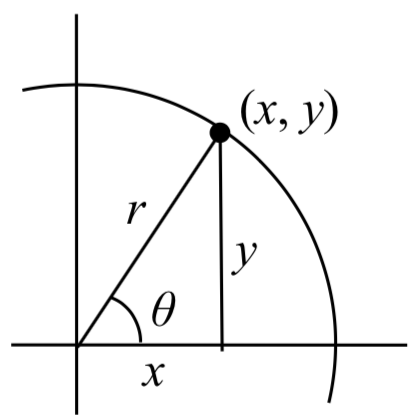
Figure \(\PageIndex{1}\)
If we drop a line segment vertically down from this point to the x axis, we would form a right triangle inside of the circle.
No matter which quadrant our angle \(\theta\) puts us in we can draw a triangle by dropping a perpendicular line segment to the \(x\) axis, keeping in mind that the values of \(x\) and \(y\) may be positive or negative, depending on the quadrant.
Additionally, if the angle \(\theta\) puts us on an axis, we simply measure the radius as the \(x\) or \(y\) with the other value being 0, again ensuring we have appropriate signs on the coordinates based on the quadrant.
Triangles obtained from different radii will all be similar triangles, meaning corresponding sides scale proportionally. While the lengths of the sides may change, the ratios of the side lengths will always remain constant for any given angle.
\(\dfrac{y_{1} }{r_{1} } =\dfrac{y_{2} }{r_{2} }\) 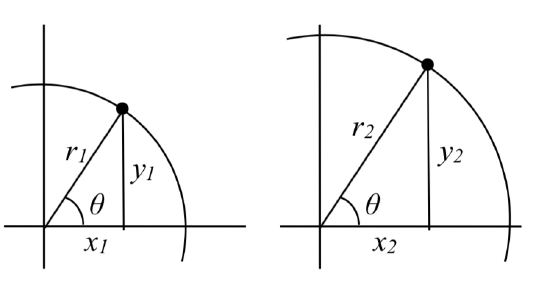
\(\dfrac{x_{1} }{r_{1} } =\dfrac{x_{2} }{r_{2} }\)
To be able to refer to these ratios more easily, we will give them names. Since the ratios depend on the angle, we will write them as functions of the angle \(\theta\).
The Six Trigonometric Functions
For the point (\(x\), \(y\)) on a circle of radius \(r\) at an angle of \(\theta\), we can define the six trigonometric functions as the ratios of the sides of the corresponding triangle:

The sine function: \(\sin (\theta )=\dfrac{y}{r}\)
The cosine function: \(\cos (\theta )=\dfrac{x}{r}\)
The tangent function: \(\tan (\theta )=\dfrac{y}{x}\)
The cosecant function: \(\csc (\theta )=\dfrac{r}{y}\)
The secant function: \(\sec (\theta )=\dfrac{r}{x}\)
The cotangent function: \(\cot (\theta )=\dfrac{x}{y}\)
Example \(\PageIndex{1}\)
The point (3, 4) is on the circle of radius 5 at some angle \(\theta\). Find the six trigonometric function values of \(\theta\)
Solution
We have \(x=3\), \(y=4\), and \(r=5\). Using the previously listed definitions we have
\[ \sin (\theta )=\dfrac{y}{r} =\dfrac{4}{5}\\ \cos (\theta )=\dfrac{x}{r} =\dfrac{3}{5}\\ \tan (\theta )=\dfrac{y}{x} =\dfrac{4}{3}\\ \csc (\theta )=\dfrac{r}{y} =\dfrac{5}{4}\\ \sec (\theta )=\dfrac{r}{x} =\dfrac{5}{3}\\ \cot (\theta )=\dfrac{x}{y} =\dfrac{3}{4} \]
Consider once again the set-up with a right triangle inscribed in a circle with radius \(r\). The two legs of the right triangle are \(x\) and \(y\) and the hypotenuse is \(r\). According to the Pythagorean Theorem we have the following relationship:
\(x^2+y^2=r^2\)
If we have a given point \( (x,y) \) on the terminal side of an angle, we can use the Pythagorean Theorem to find the length of the radius \(r\) and can then find the six trigonometric function values of the angle. 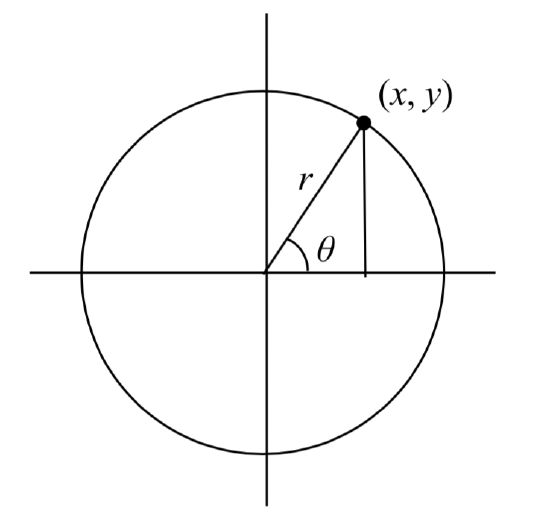
Using Right Triangles to Evaluate Trigonometric Functions
We now define the six trigonometric functions in terms of the names of the sides of a right triangle. First, let's recreate our right triangle (shown in Figure \(\PageIndex{2}\). If we drop a vertical line segment from the point \((x,y)\) to the x-axis, we have a right triangle whose vertical side has length \(y\) and whose horizontal side has length \(x\). We can use this right triangle to redefine sine, cosine, and the other trigonometric functions as ratios of the sides of a right triangle.

Figure \(\PageIndex{2}\)
We want to have another way to express the ratios without relying on a set of axes. To be able to use these ratios freely, we will give the sides more general names: Instead of \(x\),we will call the side between the given angle and the right angle the adjacent side to angle \(\theta\). (Adjacent means “next to.”) Instead of \(y\),we will call the side most distant from the given angle the opposite side from angle \(\theta\). And instead of \(r\),we will call the side of a right triangle opposite the right angle the hypotenuse. These sides are labeled in Figure \(\PageIndex{3}\).
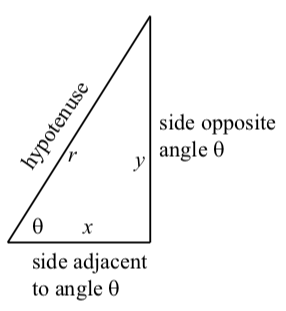
Figure \(\PageIndex{3}\): The sides of a right triangle in relation to angle \(\theta\).
Understanding Right Triangle Relationships
Given a right triangle with an acute angle of \(\theta\),
\[\begin{align} \sin (\theta) &= \dfrac{\text{opposite}}{\text{hypotenuse}} \label{sindef}\\ \cos (\theta) &= \dfrac{\text{adjacent}}{\text{hypotenuse}} \label{cosdef}\\ \tan (\theta) &= \dfrac{\text{opposite}}{\text{adjacent}} \label{tandef} \\ \csc (\theta) &= \dfrac{\text{hypotenuse}}{\text{opposite}} \label{cscdef}\\ \sec (\theta) &= \dfrac{\text{hypotenuse}}{\text{adjacent}} \label{secdef}\\ \cot (\theta) &= \dfrac{\text{adjacent}}{\text{opposite}} \label{cotdef}\\\end{align}\]
A common mnemonic for remembering these relationships is SohCahToa, formed from the first letters of “Sine is opposite over hypotenuse, Cosine is adjacent over hypotenuse, Tangent is opposite over adjacent.” To get the other three, we remember that cosecant is the reciprocal of sine, secant is the reciprocal of cosine, and cotangent is the reciprocal of tangent.
how to: Given the side lengths of a right triangle and one of the acute angles, find the sine, cosine, and tangent of that angle
- Find the sine as the ratio of the opposite side to the hypotenuse.
- Find the cosine as the ratio of the adjacent side to the hypotenuse.
- Find the tangent as the ratio of the opposite side to the adjacent side.
- Find the cosecant as the ratio of the hypotenuse to the opposite side.
- Find the secant as the ratio of the hypotenuse to the adjacent side.
- Find the cotangent as the ratio of the adjacent side to the opposite side.
Also remember that sine and cosecant are reciprocals, cosine and secant and reciprocals, and tangent and cotangent are reciprocals.
Example \(\PageIndex{2}\): Evaluating a Trigonometric Function of a Right Triangle
Given the triangle shown in Figure \(\PageIndex{4}\), find the six trigonometric function values of angle \(\alpha\).
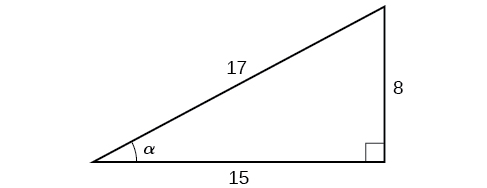
Solution
From the perspective of angle \(\alpha\), the adjacent side has length 15, the opposite side has length 8, and the hypotenuse has length 17, so we have
\[\begin{align*} \sin (\alpha) &= \dfrac{\text{O}}{\text{H}} = \dfrac{8}{17} \\ \cos (\alpha) &= \dfrac{\text{A}}{\text{H}} = \dfrac{15}{17} \\ \tan (\alpha) &= \dfrac{\text{O}}{\text{A}} = \dfrac{8}{15} \\ \csc (\alpha) &= \dfrac{\text{H}}{\text{O}} = \dfrac{17}{8} \\ \sec (\alpha) &= \dfrac{\text{H}}{\text{A}} = \dfrac{17}{15} \\ \cot (\alpha) &= \dfrac{\text{A}}{\text{O}} = \dfrac{15}{8} \end{align*}\]
Exercise \(\PageIndex{1}\)
Given the triangle shown in Figure \(\PageIndex{5}\), find the value of \(\sin t\).
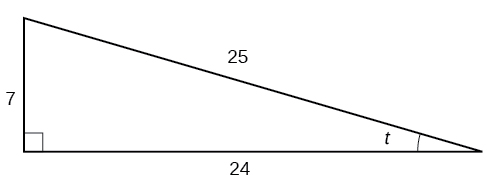
- Answer
-
\(\frac{7}{25}\)
Relating Angles and Their Functions
When working with right triangles, the same rules apply regardless of the orientation of the triangle. In fact, we can evaluate the six trigonometric functions of either of the two acute angles in the triangle in Figure \(\PageIndex{6}\). The side opposite one acute angle is the side adjacent to the other acute angle, and vice versa.
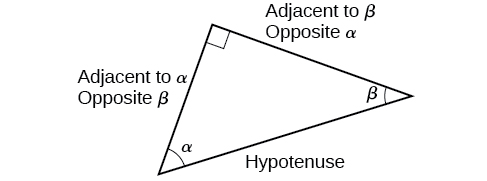
We will be asked to find all six trigonometric functions for a given angle in a triangle. Our strategy is to find the sine, cosine, and tangent of the angles first. Then, we can find the other trigonometric functions easily because we know that the reciprocal of sine is cosecant, the reciprocal of cosine is secant, and the reciprocal of tangent is cotangent.
how to: Given the side lengths of a right triangle, evaluate the six trigonometric functions of one of the acute angles
- If needed, draw the right triangle and label the angle provided.
- Identify the angle, the adjacent side, the side opposite the angle, and the hypotenuse of the right triangle.
- Find the required function:
- sine as the ratio of the opposite side to the hypotenuse
- cosine as the ratio of the adjacent side to the hypotenuse
- tangent as the ratio of the opposite side to the adjacent side
- secant as the ratio of the hypotenuse to the adjacent side
- cosecant as the ratio of the hypotenuse to the opposite side
- cotangent as the ratio of the adjacent side to the opposite side
Example \(\PageIndex{3}\): Evaluating Trigonometric Functions of Angles Not in Standard Position
Using the triangle shown in Figure \(\PageIndex{7}\), evaluate \( \sin α, \cos α, \tan α, \sec α, \csc α,\) and \( \cot α\).

Solution
\[ \begin{align*} \sin α &= \dfrac{\text{opposite } α}{\text{hypotenuse}} = \dfrac{4}{5} \\ \cos α &= \dfrac{\text{adjacent to }α}{\text{hypotenuse}}=\dfrac{3}{5} \\ \tan α &= \dfrac{\text{opposite }α}{\text{adjacent to }α}=\dfrac{4}{3} \\ \sec α &= \dfrac{\text{hypotenuse}}{\text{adjacent to }α}= \dfrac{5}{3} \\ \csc α &= \dfrac{\text{hypotenuse}}{\text{opposite }α}=\dfrac{5}{4} \\ \cot α &= \dfrac{\text{adjacent to }α}{\text{opposite }α}=\dfrac{3}{4} \end{align*}\]
Exercise \(\PageIndex{2}\)
Using the triangle shown in Figure \(\PageIndex{8}\), evaluate \( \sin t, \cos t,\tan t, \sec t, \csc t,\) and \(\cot t\).
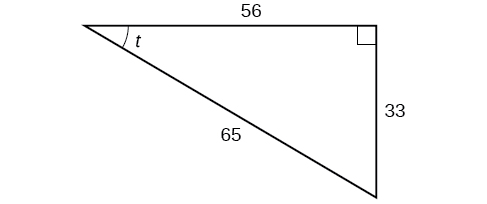
- Answer
-
\[\begin{align*} \sin t &= \frac{33}{65}, \cos t= \frac{56}{65},\tan t= \frac{33}{56}, \\ \\ \sec t &= \frac{65}{56},\csc t= \frac{65}{33},\cot t= \frac{56}{33} \end{align*}\]
Finding Trigonometric Functions of Special Angles Using Side Lengths
We now use our right triangle definitions to evaluate trigonometric values of special angles. We do this because when we evaluate the special angles in trigonometric functions, they have relatively friendly values, values that contain either no or just one square root in the ratio. Therefore, these are the angles often used in math and science problems. Our special angles are \(30°, 45°,\) and \(60°\)
Recall from geometry the \(30°,60°,90°\) triangle, which can also be described as a \(\frac{π}{6}, \frac{π}{3},\frac{π}{2}\) triangle. The sides have lengths in the relation \(s,\sqrt{3}s,2s.\) The sides of a \(45°,45°,90° \)triangle, which can also be described as a \(\frac{π}{4},\frac{π}{4},\frac{π}{2}\) triangle, have lengths in the relation \(s,s,\sqrt{2}s.\) These relations are shown in Figure \(\PageIndex{9}\).
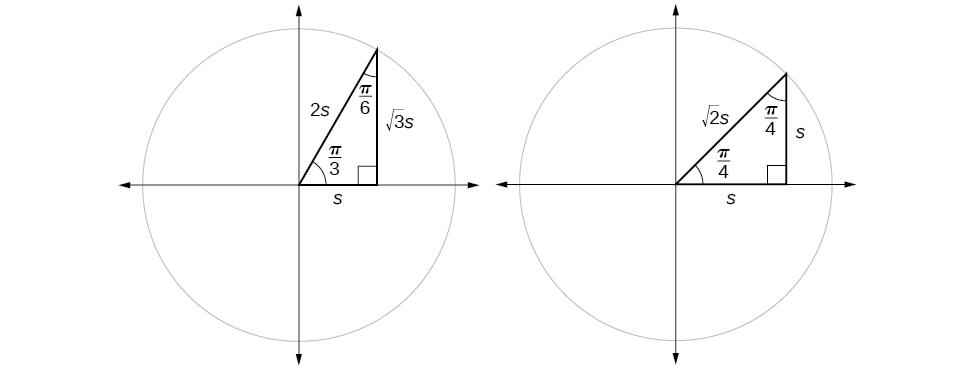
We can then use the ratios of the side lengths to evaluate trigonometric functions of special angles.
Given trigonometric functions of a special angle, evaluate using side lengths.
- Use the side lengths shown in Figure \(\PageIndex{9}\) for the special angle you wish to evaluate.
- Use the ratio of side lengths appropriate to the function you wish to evaluate.
Example \(\PageIndex{4}\): Evaluating Trigonometric Functions of Special Angles Using Side Lengths
Find the exact value of the trigonometric functions of \(\frac{π}{3}\), using side lengths.
Solution
\[\begin{align*} \sin (\dfrac{π}{3}) &= \dfrac{\text{opp}}{\text{hyp}}=\dfrac{\sqrt{3}s}{2s}=\dfrac{\sqrt{3}}{2} \\ \cos (\dfrac{π}{3}) &= \dfrac{\text{adj}}{\text{hyp}}=\dfrac{s}{2s}=\dfrac{1}{2} \\ \tan (\dfrac{π}{3}) &= \dfrac{\text{opp}}{\text{adj}} =\dfrac{\sqrt{3}s}{s}=\sqrt{3} \\ \sec (\dfrac{π}{3}) &= \dfrac{\text{hyp}}{\text{adj}} = \dfrac{2s}{s}=2 \\ \csc (\dfrac{π}{3}) &= \dfrac{\text{hyp}}{\text{opp}} =\dfrac{2s}{\sqrt{3}s}=\dfrac{2}{\sqrt{3}}=\dfrac{2\sqrt{3}}{3} \\ \cot (\dfrac{π}{3}) &= \dfrac{\text{adj}}{\text{opp}}=\dfrac{s}{\sqrt{3}s}=\dfrac{1}{\sqrt{3}}=\dfrac{\sqrt{3}}{3} \end{align*}\]
Exercise \(\PageIndex{3}\)
Find the exact value of the trigonometric functions of \(\frac{π}{4}\) using side lengths.
- Answer
-
\( \sin (\frac{π}{4})=\frac{\sqrt{2}}{2}, \cos (\frac{π}{4})=\frac{\sqrt{2}}{2}, \tan (\frac{π}{4})=1,\)
\( \sec (\frac{π}{4})=\sqrt{2}, \csc (\frac{π}{4})=\sqrt{2}, \cot (\frac{π}{4}) =1 \)
Using Equal Cofunction of Complements
If we look more closely at the relationship between the sine and cosine of the special angles relative to the unit circle, we will notice a pattern. In a right triangle with angles of \(\frac{π}{6}\) and \(\frac{π}{3}\), we see that the sine of \(\frac{π}{3}\), namely \(\frac{\sqrt{3}}{2}\), is also the cosine of \(\frac{π}{6}\), while the sine of \(\frac{π}{6}\), namely \(\frac{1}{2},\) is also the cosine of \(\frac{π}{3}\) (Figure \(\PageIndex{10}\)).
\[\begin{align*} \sin \frac{π}{3} &= \cos \frac{π}{6}=\frac{\sqrt{3}s}{2s}=\frac{\sqrt{3}}{2} \\ \sin \frac{π}{6} &= \cos \frac{π}{3}=\frac{s}{2s}=\frac{1}{2} \end{align*}\]
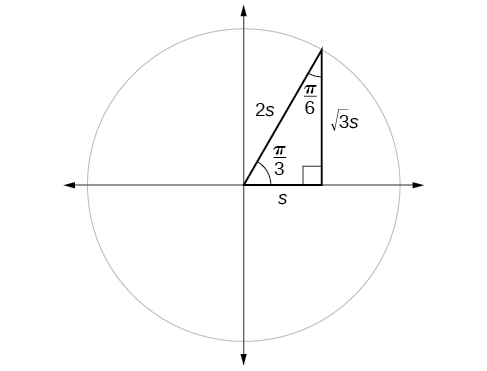
This result should not be surprising because, as we see from Figure \(\PageIndex{10}\), the side opposite the angle of \(\frac{π}{3}\) is also the side adjacent to \(\frac{π}{6}\), so \(\sin (\frac{π}{3})\) and \(\cos (\frac{π}{6})\) are exactly the same ratio of the same two sides, \(\sqrt{3} s\) and \(2s.\) Similarly, \( \cos (\frac{π}{3})\) and \( \sin (\frac{π}{6})\) are also the same ratio using the same two sides, \(s\) and \(2s\).
The interrelationship between the sines and cosines of \(\frac{π}{6}\) and \(\frac{π}{3}\) also holds for the two acute angles in any right triangle, since in every case, the ratio of the same two sides would constitute the sine of one angle and the cosine of the other. Since the three angles of a triangle add to π, π,and the right angle is \(\frac{π}{2}\), the remaining two angles must also add up to \(\frac{π}{2}\). That means that a right triangle can be formed with any two angles that add to \(\frac{π}{2}\)—in other words, any two complementary angles. So we may state a cofunction identity: If any two angles are complementary, the sine of one is the cosine of the other, and vice versa. This identity is illustrated in Figure \(\PageIndex{11}\).

Using this identity, we can state without calculating, for instance, that the sine of \(\frac{π}{12}\) equals the cosine of \(\frac{5π}{12}\), and that the sine of \(\frac{5π}{12}\) equals the cosine of \(\frac{π}{12}\). We can also state that if, for a certain angle \(t, \cos t= \frac{5}{13},\) then \( \sin (\frac{π}{2}−t)=\frac{5}{13}\) as well.
COFUNCTION IDENTITIES
The cofunction identities in radians are listed in Table \(\PageIndex{1}\).
|
\( \cos t= \sin (\frac{π}{2}−t)\) |
\( \sin t= \cos (\dfrac{π}{2}−t)\) |
|
\( \tan t= \cot (\dfrac{π}{2}−t) \) |
\( \cot t= \tan (\dfrac{π}{2}−t)\) |
|
\( \sec t= \csc (\dfrac{π}{2}−t) \) |
\( \csc t= \sec (\dfrac{π}{2}−t)\) |
how to: Given the sine and cosine of an angle, find the sine or cosine of its complement.
- To find the sine of the complementary angle, find the cosine of the original angle.
- To find the cosine of the complementary angle, find the sine of the original angle.
Example \(\PageIndex{5}\): Using Cofunction Identities
If \( \sin t = \frac{5}{12},\) find \(( \cos \frac{π}{2}−t)\).
Solution
According to the cofunction identities for sine and cosine,
\[ \sin t= \cos (\dfrac{π}{2}−t). \nonumber\]
So
\[ \cos (\dfrac{π}{2}−t)= \dfrac{5}{12}. \nonumber\]
Exercise \(\PageIndex{4}\)
If \(\csc (\frac{π}{6})=2,\) find \( \sec (\frac{π}{3}).\)
Solution
2
Using Trigonometric Functions
In previous examples, we evaluated the sine and cosine in triangles where we knew all three sides. But the real power of right-triangle trigonometry emerges when we look at triangles in which we know an angle but do not know all the sides.
how to: Given a right triangle, the length of one side, and the measure of one acute angle, find the remaining sides
- For each side, select the trigonometric function that has the unknown side as either the numerator or the denominator. The known side will in turn be the denominator or the numerator.
- Write an equation setting the function value of the known angle equal to the ratio of the corresponding sides.
- Using the value of the trigonometric function and the known side length, solve for the missing side length.
Example \(\PageIndex{6}\): Finding Missing Side Lengths Using Trigonometric Ratios
Find the unknown sides of the triangle in Figure \(\PageIndex{12}\).
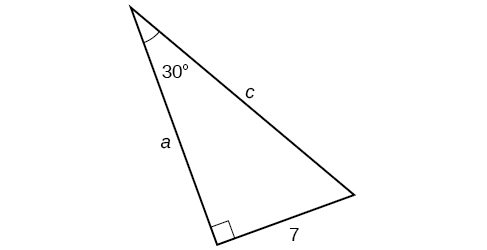
Solution
We know the angle and the opposite side, so we can use the tangent to find the adjacent side.
\[ \tan (30°)= \dfrac{7}{a} \nonumber\]
We rearrange to solve for \(a\).
\[\begin{align} a &=\dfrac{7}{ \tan (30°)} \\ & =12.1 \end{align} \nonumber\]
We can use the sine to find the hypotenuse.
\[ \sin (30°)= \dfrac{7}{c} \nonumber\]
Again, we rearrange to solve for \(c\).
\[\begin{align*} c &= \dfrac{7}{\sin (30°)} =14 \end{align*}\]
Exercise \(\PageIndex{5}\):
A right triangle has one angle of \(\frac{π}{3}\) and a hypotenuse of 20. Find the unknown sides and angle of the triangle.
- Answer
-
\(\mathrm{adjacent=10; opposite=10 \sqrt{3}; }\) missing angle is \(\frac{π}{6}\)
Using Right Triangle Trigonometry to Solve Applied Problems
Right-triangle trigonometry has many practical applications. For example, the ability to compute the lengths of sides of a triangle makes it possible to find the height of a tall object without climbing to the top or having to extend a tape measure along its height. We do so by measuring a distance from the base of the object to a point on the ground some distance away, where we can look up to the top of the tall object at an angle. The angle of elevation of an object above an observer relative to the observer is the angle between the horizontal and the line from the object to the observer's eye. The right triangle this position creates has sides that represent the unknown height, the measured distance from the base, and the angled line of sight from the ground to the top of the object. Knowing the measured distance to the base of the object and the angle of the line of sight, we can use trigonometric functions to calculate the unknown height. Similarly, we can form a triangle from the top of a tall object by looking downward. The angle of depression of an object below an observer relative to the observer is the angle between the horizontal and the line from the object to the observer's eye. See Figure \(\PageIndex{13}\).
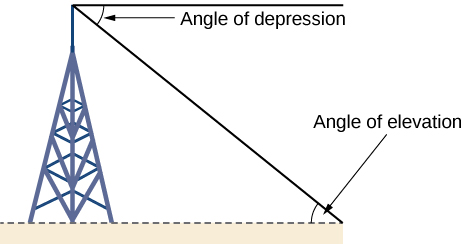
how to: Given a tall object, measure its height indirectly
- Make a sketch of the problem situation to keep track of known and unknown information.
- Lay out a measured distance from the base of the object to a point where the top of the object is clearly visible.
- At the other end of the measured distance, look up to the top of the object. Measure the angle the line of sight makes with the horizontal.
- Write an equation relating the unknown height, the measured distance, and the tangent of the angle of the line of sight.
- Solve the equation for the unknown height.
Example \(\PageIndex{7}\): Measuring a Distance Indirectly
To find the height of a tree, a person walks to a point 30 feet from the base of the tree. She measures an angle of 57° between a line of sight to the top of the tree and the ground, as shown in Figure \(\PageIndex{14}\). Find the height of the tree.
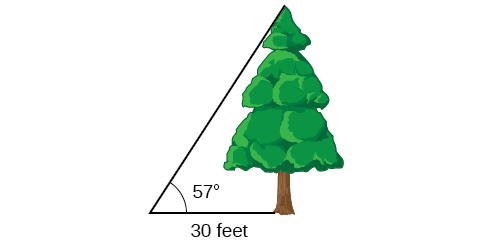
Solution
We know that the angle of elevation is \(57°\) and the adjacent side is 30 ft long. The opposite side is the unknown height.
The trigonometric function relating the side opposite to an angle and the side adjacent to the angle is the tangent. So we will state our information in terms of the tangent of \(57°\), letting \(h\) be the unknown height.
\[\begin{array}{cl} \tan θ = \dfrac{\text{opposite}}{\text{adjacent}} & \text{} \\ \tan (57°) = \dfrac{h}{30} & \text{Solve for }h. \\ h=30 \tan (57°) & \text{Multiply.} \\ h≈46.2 & \text{Use a calculator.} \end{array} \]
The tree is approximately 46 feet tall.
Exercise \(\PageIndex{6}\):
How long a ladder is needed to reach a windowsill 50 feet above the ground if the ladder rests against the building making an angle of \(\frac{5π}{12}\) with the ground? Round to the nearest foot.
- Answer
-
About 52 ft
media:
Access these online resources for additional instruction and practice with right triangle trigonometry.
Visit this website for additional practice questions from Learningpod.
Key Equations
Cofunction Identities
\[\begin{align*} \cos t &= \sin ( \frac{π}{2}−t) \\ \sin t &= \cos (\frac{π}{2}−t) \\ \tan t &= \cot (\frac{π}{2}−t) \\ \cot t &= \tan (\frac{π}{2}−t) \\ \sec t &= \csc (\frac{π}{2}−t) \\ \csc t &= \sec (\frac{π}{2}−t) \end{align*}\]
Key Concepts
- We can define trigonometric functions as ratios of the side lengths of a right triangle. See Example.
- The same side lengths can be used to evaluate the trigonometric functions of either acute angle in a right triangle. See Example.
- We can evaluate the trigonometric functions of special angles, knowing the side lengths of the triangles in which they occur. See Example.
- Any two complementary angles could be the two acute angles of a right triangle.
- If two angles are complementary, the cofunction identities state that the sine of one equals the cosine of the other and vice versa. See Example.
- We can use trigonometric functions of an angle to find unknown side lengths.
- Select the trigonometric function representing the ratio of the unknown side to the known side. See Example.
- Right-triangle trigonometry permits the measurement of inaccessible heights and distances.
- The unknown height or distance can be found by creating a right triangle in which the unknown height or distance is one of the sides, and another side and angle are known. See Example.
Glossary
- adjacent side
- in a right triangle, the side between a given angle and the right angle
- angle of depression
- the angle between the horizontal and the line from the object to the observer’s eye, assuming the object is positioned lower than the observer
- angle of elevation
- the angle between the horizontal and the line from the object to the observer’s eye, assuming the object is positioned higher than the observer
- opposite side
- in a right triangle, the side most distant from a given angle
- hypotenuse
- the side of a right triangle opposite the right angle


